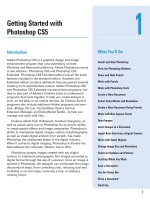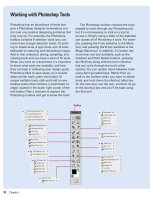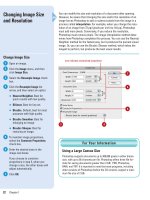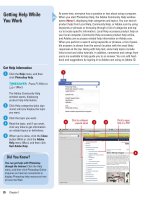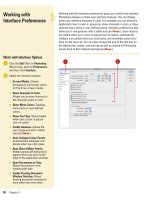Photoshop cs5 by steve Johnson part 20 pptx
Bạn đang xem bản rút gọn của tài liệu. Xem và tải ngay bản đầy đủ của tài liệu tại đây (457.18 KB, 5 trang )
ptg
122 Chapter 5
The Layer Properties dialog box gives you control over two very impor-
tant characteristics of a layer: the layer's name and its identifying
color. For example, if you're working on a document with 20 layers and
you're not naming the layers, after a while you'll lose track of each
layer's contents. When you name your layers, you have a visual identi-
fier of the information contained within that specific layer (assuming
you name the layer correctly). In addition, you can use the Colorize
option to apply a color to a specific group of layers—coloring all the
type layers red, for example. Layer properties may not seem that impor-
tant, but they go a long way towards helping you organize a complex,
multi-layered document.
Changing Layer
Properties
Change Layer Properties
Select the Layers panel.
Click the Layers Options button,
and then click Layer Properties.
TIMESAVER
Hold down the Alt
(Win) or Option (Mac) key and
double-click a layer name to open
Layer Properties.
Change the name of the layer.
Click the Color list arrow, and then
click a layer color.
Click OK.
5
4
3
2
1
2
3
5
4
1
From the Library of Wow! eBook
ptg
Chapter 5 Working with Layers 123
Layer Comps are an image or snapshot of the current state of the
Layers panel. When you create a Layer Comp, you're recording layer
visibility, a layer's position within the document, and any layer styles
applied to the image. Making changes to the layers in your document
and then updating the Layer Comps panel creates a new Layer Comp.
Any time you want to view a particular Layer Comp, just select it from
the Layer Comps panel. Layer Comps create different versions of your
document and saves them all in one file, giving you different creative
options for the same document. In addition, they give you the option of
printing the same document with different variations, by choosing dif-
ferent Layer Comps during printing.
Working with the
Layer Comps Panel
Work with the Layer
Comps Panel
Open a document.
Click the Window menu, and then
click Layer Comps to open the
Layer Comps panel.
Click the Create New Layer Comp
button to create a snapshot of the
current state of the image.
Select check boxes to adjust a
layer's visibility, position, or
appearance (layer style).
Click OK.
Click the Create New Layer Comp
button to create another snapshot
of the current state of the image.
Repeat steps 4 and 5 to create as
many layer comps as you need.
Click the left and right arrows to
cycle through the current layer
comps.
Click the Update Layer Comp
button to update the selected layer
comp to the current state of the
image.
Click the Layer Comp icon to
change the active image to the
selected layer comp state.
To remove a layer comp, cli ck the
Delete Layer Comp button.
11
10
9
8
7
6
5
4
3
2
1
2
4
5
3
From the Library of Wow! eBook
ptg
124 Chapter 5
Photoshop gives you the option of exporting and saving layers as indi-
vidual files using a variety of formats including PSD, BMP, JPEG, PDF,
Targa, TIFF, and PNG. When exporting layers to files, one format is
applied to all exported layers. The Export Layers to Files script com-
mand gives you the ability to create individual files from the individual
layers and select options specific to the file format you want.
Exporting Layers
as Files
Export Layers to Files
Open a document.
Click the File menu, point to
Scripts, and then click Export
Layers to Files.
To specify a destination for th e
files, click Browse, and then select
a folder location.
Enter the name you want at the
beginning of the files.
To export onl y visible layers, click
the Visible Layers Only check box.
Click the File Type list arrow, and
then select an output option: PSD,
BMP, JPEG, PDF, Targa, TIFF, PNG-
8, or PNG-24.
To embed a color profile, s el ec t
the Include ICC Profile check box.
Specify the options you want that
relate to the selected file format.
Click Run.
Upon completion, click OK.
The files are named with the prefix
you specified and numbered in
sequential order.
10
9
8
7
6
5
4
3
2
1
9
3
5
4
6
8
7
10
From the Library of Wow! eBook
ptg
Chapter 5 Working with Layers 125
Photoshop doesn't have a lot of options for controlling the Layers panel
itself; in fact, there is only one—changing the size of the layer thumb-
nail and how it fits within the thumbnail box. You can choose to view
the layer thumbnail in a small, medium, or large size, or you can select
to have no thumbnail shown at all. When you change the size of the
thumbnail, you're instructing Photoshop to spend either more, or less,
processing time on the display of the image. The larger the thumbnail,
the easier it is to see, but the longer it takes for Photoshop to draw the
image in the Layers panel. If you're experiencing performance issues
with Photoshop, and you're using the large thumbnail size option, you
might consider choosing a smaller thumbnail size.
Setting Layers Panel
Options
Set Layers Panel Options
Select the Layers panel.
Click the Layers Options button,
and then click Panel Options.
Click a thumbnail size or the None
option.
Click the Layer Bounds or Entire
Document option.
Select the options you want:
◆ Use Default Masks on Fill
Layers. Select to automatically
insert a mask when creating a
new Adjustment layer.
◆ Expand New Effects. Select if
you would like to view Smart
Filters or Layer Styles in the
Layers panel. You can also click
the triangle next to the Smart
Filter or Layer Style icon in the
Layers panel.
◆ Add “copy” to Copied Layers
and Groups. Select to add the
text “copy” to copied layers or
layer groups (New!).
Click OK.
6
5
4
3
2
1
2
3
6
1
4
5
From the Library of Wow! eBook
ptg
126 Chapter 5
Photoshop gives you the ability to use Smart Guides to help align
shapes, slices, and selections as you draw. They appear automatically
as you draw a shape or create a selection or slice, and then disappear
after the shape is drawn. They enable you to visually align one object to
another with a minimum of effort. Smart Guides are automatically
turned on by default.
Using Smart Guides
Use Smart Guides
Open or create a multi-layered
document.
Select a layer that contains an
object.
Select the Move tool, and drag the
object.
As you move the object, Smart
Guides appear to help you align
the objects.
Release the mouse and the guides
disappear.
4
3
2
1
1
3
2
Smart
Guide
Did You Know?
You can turn Smart Guides on and off.
Click the View menu, point to Show,
and then click Smart Guides.
From the Library of Wow! eBook
